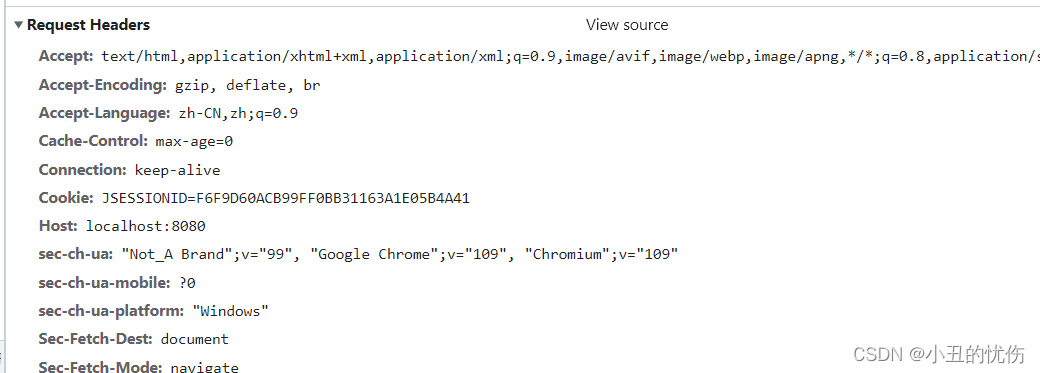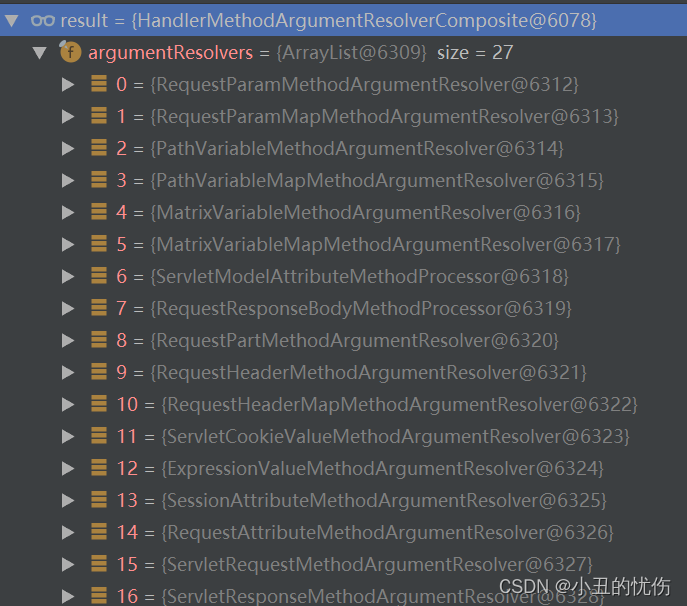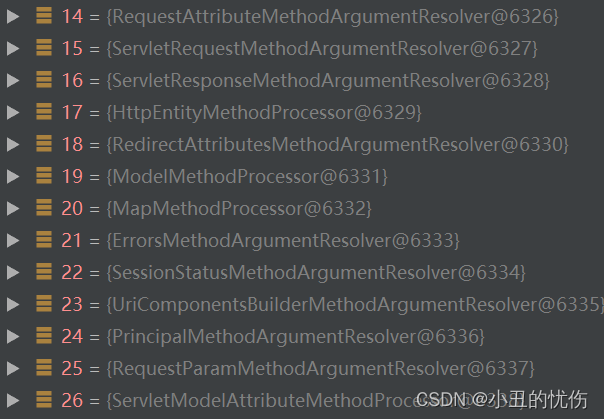springboot 注解
SpringBoot 注解
2023-09-11 14:19:18 时间
上一篇:初识springboot
接收参数常用注解
@RequestBody
常用于POST表单提交参数接收
@RequestMapping("/test")
public String test(@RequestBody String data){
return data;
}@PathVariable
获取路径上的参数:
/test/{id}
@RequestMapping("/test/{id}")
public String test(@PathVariable("id")String id){
return "hello world !";
}@RequestParam
获取常规参数:
/test?id=123
@RequestMapping("/test")
public String test(@RequestParam("id")String name){
return "hello world !";
}@RequestHeader
获取请求头中的数据:host

@RequestMapping("/test")
public String test(@RequestHeader("host")String id){
return id;
}@CookieValue
获取Cookie参数信息

@RequestMapping("/test")
public String test(@CookieValue("JSESSIONID")String id){
return id;
}参数解析器:
请求接口时通过DispatcherServlet中的
protected void doDispatch(HttpServletRequest request, HttpServletResponse response) throws Exception {
HttpServletRequest processedRequest = request;
HandlerExecutionChain mappedHandler = null;
boolean multipartRequestParsed = false;
WebAsyncManager asyncManager = WebAsyncUtils.getAsyncManager(request);
try {
ModelAndView mv = null;
Exception dispatchException = null;
try {
processedRequest = checkMultipart(request);
multipartRequestParsed = (processedRequest != request);
// Determine handler for the current request.
mappedHandler = getHandler(processedRequest);
if (mappedHandler == null) {
noHandlerFound(processedRequest, response);
return;
}
// Determine handler adapter for the current request.
HandlerAdapter ha = getHandlerAdapter(mappedHandler.getHandler());
// Process last-modified header, if supported by the handler.
String method = request.getMethod();
boolean isGet = HttpMethod.GET.matches(method);
if (isGet || HttpMethod.HEAD.matches(method)) {
long lastModified = ha.getLastModified(request, mappedHandler.getHandler());
if (new ServletWebRequest(request, response).checkNotModified(lastModified) && isGet) {
return;
}
}
if (!mappedHandler.applyPreHandle(processedRequest, response)) {
return;
}
// 执行处理数据主要方法
// Actually invoke the handler.
mv = ha.handle(processedRequest, response, mappedHandler.getHandler());
if (asyncManager.isConcurrentHandlingStarted()) {
return;
}
applyDefaultViewName(processedRequest, mv);
mappedHandler.applyPostHandle(processedRequest, response, mv);
}
catch (Exception ex) {
dispatchException = ex;
}
catch (Throwable err) {
// As of 4.3, we're processing Errors thrown from handler methods as well,
// making them available for @ExceptionHandler methods and other scenarios.
dispatchException = new NestedServletException("Handler dispatch failed", err);
}
processDispatchResult(processedRequest, response, mappedHandler, mv, dispatchException);
}
catch (Exception ex) {
triggerAfterCompletion(processedRequest, response, mappedHandler, ex);
}
catch (Throwable err) {
triggerAfterCompletion(processedRequest, response, mappedHandler,
new NestedServletException("Handler processing failed", err));
}
finally {
if (asyncManager.isConcurrentHandlingStarted()) {
// Instead of postHandle and afterCompletion
if (mappedHandler != null) {
mappedHandler.applyAfterConcurrentHandlingStarted(processedRequest, response);
}
}
else {
// Clean up any resources used by a multipart request.
if (multipartRequestParsed) {
cleanupMultipart(processedRequest);
}
}
}
}
然后到映射器适配器
public class RequestMappingHandlerAdapter extends AbstractHandlerMethodAdapter
implements BeanFactoryAware, InitializingBean {
中的方法
@Nullable
protected ModelAndView invokeHandlerMethod(HttpServletRequest request,
HttpServletResponse response, HandlerMethod handlerMethod) throws Exception {
ServletWebRequest webRequest = new ServletWebRequest(request, response);
try {
WebDataBinderFactory binderFactory = getDataBinderFactory(handlerMethod);
ModelFactory modelFactory = getModelFactory(handlerMethod, binderFactory);
ServletInvocableHandlerMethod invocableMethod = createInvocableHandlerMethod(handlerMethod);
参数处理器
if (this.argumentResolvers != null) {
invocableMethod.setHandlerMethodArgumentResolvers(this.argumentResolvers);
}
返回数据处理器
if (this.returnValueHandlers != null) {
invocableMethod.setHandlerMethodReturnValueHandlers(this.returnValueHandlers);
}
invocableMethod.setDataBinderFactory(binderFactory);
invocableMethod.setParameterNameDiscoverer(this.parameterNameDiscoverer);
ModelAndViewContainer mavContainer = new ModelAndViewContainer();
mavContainer.addAllAttributes(RequestContextUtils.getInputFlashMap(request));
modelFactory.initModel(webRequest, mavContainer, invocableMethod);
mavContainer.setIgnoreDefaultModelOnRedirect(this.ignoreDefaultModelOnRedirect);
AsyncWebRequest asyncWebRequest = WebAsyncUtils.createAsyncWebRequest(request, response);
asyncWebRequest.setTimeout(this.asyncRequestTimeout);
WebAsyncManager asyncManager = WebAsyncUtils.getAsyncManager(request);
asyncManager.setTaskExecutor(this.taskExecutor);
asyncManager.setAsyncWebRequest(asyncWebRequest);
asyncManager.registerCallableInterceptors(this.callableInterceptors);
asyncManager.registerDeferredResultInterceptors(this.deferredResultInterceptors);
if (asyncManager.hasConcurrentResult()) {
Object result = asyncManager.getConcurrentResult();
mavContainer = (ModelAndViewContainer) asyncManager.getConcurrentResultContext()[0];
asyncManager.clearConcurrentResult();
LogFormatUtils.traceDebug(logger, traceOn -> {
String formatted = LogFormatUtils.formatValue(result, !traceOn);
return "Resume with async result [" + formatted + "]";
});
invocableMethod = invocableMethod.wrapConcurrentResult(result);
}
invocableMethod.invokeAndHandle(webRequest, mavContainer);
if (asyncManager.isConcurrentHandlingStarted()) {
return null;
}
return getModelAndView(mavContainer, modelFactory, webRequest);
}
finally {
webRequest.requestCompleted();
}
}数据处理,启动项目后注册到容器的数据类型


返回数据处理器数据类型

@Component
是spring中的注解,描述spring中的bean,标识是容器中的一个组件(类)
@Service
是Spring中的注解,通常用于业务层实现类上,标识是spring中的bean,该注解的实现是
@Component
@RestController
@Controller是Spring中的注解,通常用于控制器上,标识是spring中的bean,该注解的实现是
@Component,
@RestController实现是由@Controller+@ResponseBody
@Autowired
@Target({ElementType.CONSTRUCTOR, ElementType.METHOD, ElementType.PARAMETER
, ElementType.FIELD, ElementType.ANNOTATION_TYPE})
@Retention(RetentionPolicy.RUNTIME)
@Documented
public @interface Autowired {
boolean required() default true;
}该注解可用于:
1、构造方法上(ElementType.CONSTRUCTOR)
2、方法上( ElementType.METHOD)
3、参数上(ElementType.PARAMETER)
4、属性上(ElementType.FIELD) 常用
5、注解上(ElementType.ANNOTATION_TYPE)
注入的方式还有:指定类名注入
@Autowired
@Qualifier(value = "实现类的类名首字母小写")
// 常用于一个接口多个实现类的时候使用指定实现类的方式
@Resource
@Target({ElementType.TYPE, ElementType.FIELD, ElementType.METHOD})
@Retention(RetentionPolicy.RUNTIME)
@Repeatable(Resources.class)
public @interface Resource {
String name() default "";
String lookup() default "";
Class<?> type() default Object.class;
Resource.AuthenticationType authenticationType() default Resource.AuthenticationType.CONTAINER;
boolean shareable() default true;
String mappedName() default "";
String description() default "";
public static enum AuthenticationType {
CONTAINER,
APPLICATION;
private AuthenticationType() {
}
}
}@Resources 是多个注入
@Resource注解也可以完成属性注入
与@Autowired的区别:
@Resource
1、@Resource注解是JDK扩展包中的,是JDK的一部分,所以改注解是标准注解,更具有通用性。
2、@Resource注解默认根据名称装配(byName),未指定name时,使用属性名作为name。通过neame找不到的话会自动启动通过类型(byType)装配
3、@Resource注解用在属性上、setter方法上
JDK版本低于1.8或者高于11需要引入依赖:
<dependency>
<groupId>jakarta.annotation</groupId>
<artifactId>jakarta.annotation-api</artifactId>
</dependency>
@Autowired
1、是spring框架自己的注解
2、默认根据类型(byType)装配,如果需要根据名称装配,需要配合@Qualifier注解一起使用
3、用在属性上、setter方法上、构造方法上、构造方法参数上
@Configuration
@Target({ElementType.TYPE})
@Retention(RetentionPolicy.RUNTIME)
@Documented
@Component
public @interface Configuration {
@AliasFor(
annotation = Component.class
)
String value() default "";
boolean proxyBeanMethods() default true;
}该注解标识这个类是一个配置类,是spring的bean,最终实现是@Component
@SpringBootApplication
@Target({ElementType.TYPE})
@Retention(RetentionPolicy.RUNTIME)
@Documented
@Inherited
@SpringBootConfiguration
@EnableAutoConfiguration
@ComponentScan(
excludeFilters = {@Filter(
type = FilterType.CUSTOM,
classes = {TypeExcludeFilter.class}
), @Filter(
type = FilterType.CUSTOM,
classes = {AutoConfigurationExcludeFilter.class}
)}
)
public @interface SpringBootApplication {
@AliasFor(
annotation = EnableAutoConfiguration.class
)
Class<?>[] exclude() default {};
@AliasFor(
annotation = EnableAutoConfiguration.class
)
String[] excludeName() default {};
@AliasFor(
annotation = ComponentScan.class,
attribute = "basePackages"
)
String[] scanBasePackages() default {};
@AliasFor(
annotation = ComponentScan.class,
attribute = "basePackageClasses"
)
Class<?>[] scanBasePackageClasses() default {};
@AliasFor(
annotation = ComponentScan.class,
attribute = "nameGenerator"
)
Class<? extends BeanNameGenerator> nameGenerator() default BeanNameGenerator.class;
@AliasFor(
annotation = Configuration.class
)
boolean proxyBeanMethods() default true;
}
是一个Springboot复核注解,由
@SpringBootConfiguration
@EnableAutoConfiguration
@ComponentScan
三个注解实现
@SpringBootConfiguration
@Target({ElementType.TYPE})
@Retention(RetentionPolicy.RUNTIME)
@Documented
@Configuration
@Indexed
public @interface SpringBootConfiguration {
@AliasFor(
annotation = Configuration.class
)
boolean proxyBeanMethods() default true;
}该注解的实现是@Configuration
@EnableAutoConfiguration
@Target({ElementType.TYPE})
@Retention(RetentionPolicy.RUNTIME)
@Documented
@Inherited
@AutoConfigurationPackage
@Import({AutoConfigurationImportSelector.class})
public @interface EnableAutoConfiguration {
String ENABLED_OVERRIDE_PROPERTY = "spring.boot.enableautoconfiguration";
Class<?>[] exclude() default {};
String[] excludeName() default {};
}而该类的实现是@AutoConfigurationPackage 和 导入的一个类AutoConfigurationImportSelector.class。
@AutoConfigurationPackage
@Target(ElementType.TYPE)
@Retention(RetentionPolicy.RUNTIME)
@Documented
@Inherited
@Import(AutoConfigurationPackages.Registrar.class)
public @interface AutoConfigurationPackage {
/**
* Base packages that should be registered with {@link AutoConfigurationPackages}.
* <p>
* Use {@link #basePackageClasses} for a type-safe alternative to String-based package
* names.
* @return the back package names
* @since 2.3.0
*/
String[] basePackages() default {};
/**
* Type-safe alternative to {@link #basePackages} for specifying the packages to be
* registered with {@link AutoConfigurationPackages}.
* <p>
* Consider creating a special no-op marker class or interface in each package that
* serves no purpose other than being referenced by this attribute.
* @return the base package classes
* @since 2.3.0
*/
Class<?>[] basePackageClasses() default {};
}
AutoConfigurationPackages.Registrar.class 是AutoConfigurationPackages中的一个内部类
/**
* {@link ImportBeanDefinitionRegistrar} to store the base package from the importing
* configuration.
*/
static class Registrar implements ImportBeanDefinitionRegistrar, DeterminableImports {
@Override
public void registerBeanDefinitions(AnnotationMetadata metadata, BeanDefinitionRegistry registry) {
register(registry, new PackageImports(metadata).getPackageNames().toArray(new String[0]));
}
@Override
public Set<Object> determineImports(AnnotationMetadata metadata) {
return Collections.singleton(new PackageImports(metadata));
}
}@ComponentScan
是一个扫描类,默认扫描springboot主类同级别开始的所有包,或者指定扫描包路径
相关文章
- 基于SpringBoot的多模块项目引入其他模块时@Autowired无法注入其他模块stereotype注解类对象的问题解决
- 12章 搜索框架ElasticSearch介绍和整合SpringBoot 4节课
- 补习系列(8)-springboot 单元测试之道
- SpringBoot入门之基于注解的Mybatis
- SpringBoot ( 七 ) :springboot + mybatis 多数据源最简解决方案
- springboot+vue实现前后端分离之后端spring部分(spring boot 2.5.4/vue.js 3.2.4)
- SpringBoot标签之@ConfigurationProperties、@PropertySource注解的使用
- springboot+dubbo + zookeeper 案例
- springboot添加mybatis数据库依赖
- SpringBoot中@Mapper和@Repository注解的区别
- 基于注解SpringAOP,AfterReturning,Before,Around__springboot工程 @Around 简单的使用__SpringBoot:AOP 自定义注解实现日志管理
- Springboot-@Value属性注入properties或yml文件
- SpringBoot 常用注解
- springboot启动报错:application.yml 里 Do not use @ for indentation in 'reader', line
- Java:SpringBoot启动时打印当前端口
- Springboot问题解决:javax.servlet.ServletException: Circular view path [login]: would dispatch...
- Springboot扩展点之CommandLineRunner和ApplicationRunner
- 仓库管理系统-前后端分离项目(SpringBoot+Vue)
- 【springboot】15、文件上传
- springboot项目上传到云服务器运行war
- springboot注解
- springboot使用jxls导出excel___(万能通用模板)--- SpringBoot导入、导出Excel文件___SpringBoot整合EasyExcel模板导出Excel
- SpringBoot与日志配置
- springboot集成webService开发详解

